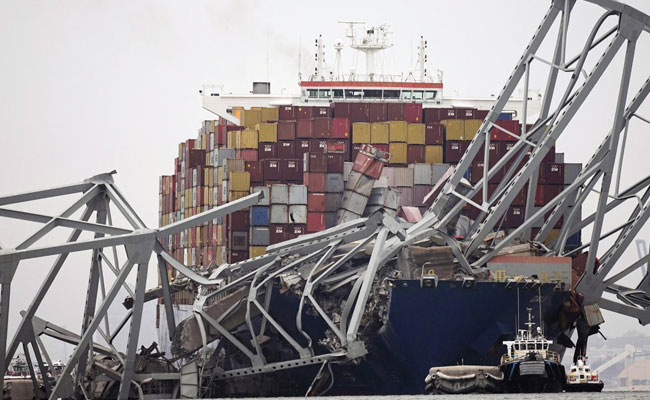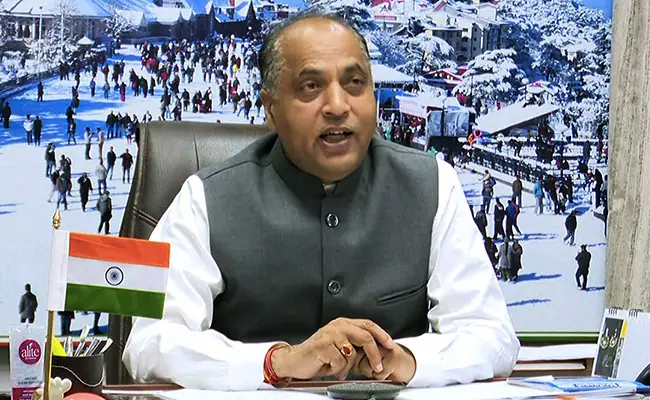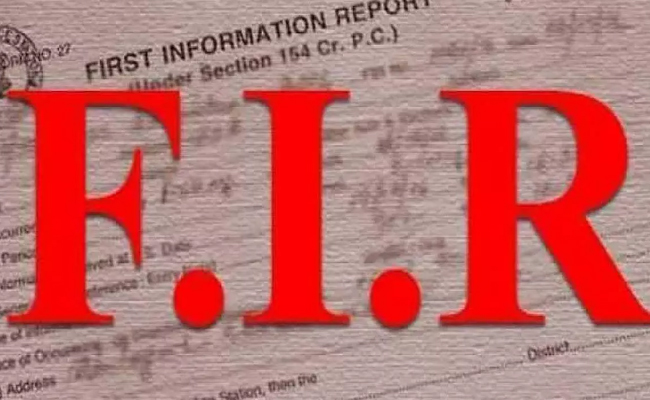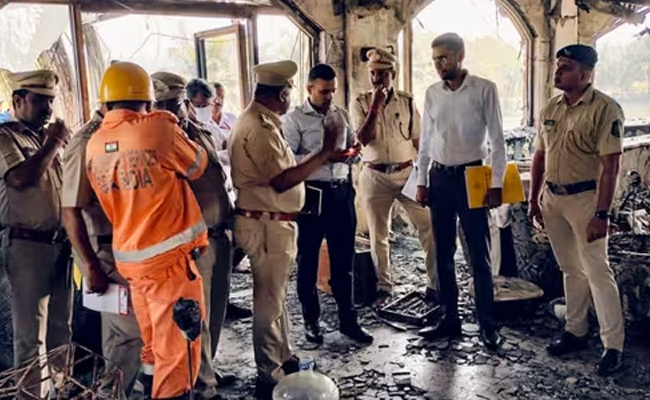Baltimore (AP/PTI): Investigators began collecting evidence from the cargo ship that plowed into Baltimore's Francis Scott Key Bridge and caused its collapse, while in the waters below divers searched through twisted metal for six construction workers who plunged into the harbour. The bodies of two were recovered Wednesday, and the others were presumed dead.
The bodies of the two men, aged 35 and 26, were located by divers inside a red pickup submerged in about 25 feet of water near the bridge's middle span, Col Roland L Butler Jr, superintendent of Maryland State Police, announced at an evening news conference.
The victims were from Mexico, Guatemala, Honduras and El Salvador, Butler said.
The investigation picked up speed as the Baltimore region reeled from the sudden loss of a major transportation link that's part of the highway loop around the city. The disaster also closed the port that is vital to the city's shipping industry.
Officials with the National Transportation Safety Board boarded the ship and planned to recover information from its electronics and paperwork, NTSB Chair Jennifer Homendy said.
The agency also is reviewing the voyage data recorder recovered by the Coast Guard and building a timeline of what led to the crash, which federal and state officials have said appeared to be an accident.
The ship's crew issued a mayday call early Tuesday, saying they had lost power and the vessel's steering system just minutes before striking one of the bridge's columns.
At least eight people went into the water. Two were rescued, but the other six -- part of a construction crew that was filling potholes on the bridge -- were missing and presumed dead.
The debris complicated the search, according to a Homeland Security memo described to AP by a law enforcement official. The official was not authorised to discuss details of the document or the investigation and spoke to AP on condition of anonymity.
Maryland Governor Wes Moore said the divers faced dangerous conditions.
Among the missing were people from Guatemala, Honduras and Mexico, according to diplomats from those countries.
One worker, a 38-year-old man from Honduras who came to the US nearly two decades ago, was described by his brother as entrepreneurial and hard-working. He started last fall with the company that was performing maintenance on the bridge.
Capt Michael Burns Jr of the Maritime Center for Responsible Energy said bringing a ship into or out of ports with limited room to maneuver is 'one of the most technically challenging and demanding things that we do".
There are "few things that are scarier than a loss of power in restricted waters", he said.
The last-minute warning from the ship allowed police just enough time to stop traffic on the interstate highway.
Attention also turned to the container ship Dali and its past.
Synergy Marine Group, which manages the ship, said the impact happened while it was under the control of one or more pilots, who are local specialists who help guide vessels safely in and out of ports.
The ship, which was headed from Baltimore to Sri Lanka, is owned by Grace Ocean Private Ltd, and Danish shipping giant Maersk said it had chartered the vessel.
The vessel passed foreign port state inspections in June and September 2023. In the June 2023 inspection, a faulty monitor gauge for fuel pressure was rectified before the vessel departed the port, Singapore's port authority said in a statement Wednesday.
The ship was travelling under a Singapore flag, and officials there said they will be conducting their own investigation in addition to supporting US authorities.
The sudden loss of a highway that carries 30,000 vehicles a day, and the disruption of a vital shipping port, will affect not only thousands of dockworkers and commuters but also US consumers who are likely to feel the impact of shipping delays.
The Port of Baltimore is a busy entry point along the East Coast for new vehicles made in Germany, Mexico, Japan and the UK, along with coal and farm equipment.
Ship traffic entering and leaving the port has been suspended indefinitely. Windward Maritime, a maritime risk-management company, said its data shows a large increase in ships that are waiting for a port to go to, with some anchored outside Baltimore or nearby Annapolis.
Transportation Secretary Pete Buttigieg said the Biden administration was focused on reopening the port and rebuilding the bridge, but he avoided putting a timeline on those efforts.
Another priority is dealing with shipping issues, and Buttigieg planned to meet Thursday with supply chain officials.
From 1960 to 2015, there were 35 major bridge collapses worldwide due to ship or barge collisions, according to the World Association for Waterborne Transport Infrastructure.
Let the Truth be known. If you read VB and like VB, please be a VB Supporter and Help us deliver the Truth to one and all.
Visakhapatnam (PTI): Shafali Verma hit a blistering unbeaten 69 as India made short work of a paltry target to outclass Sri Lanka by seven wickets in the second Women’s T20 International here on Tuesday.
India now lead the five-match series 2-0 after another one-sided victory, having restricted Sri Lanka to a modest 128 for 9 through a collective display of disciplined bowling from the spin trio of seasoned Sneh Rana, ably complemented by young spinners Vaishnavi Sharma and Shree Charani.
During the chase, vice-captain Smriti Mandhana (14) fell cheaply but Shafali, enjoying new found confidence after a stellar show in the World Cup final, sent the bowlers on a leather-hunt during her 34-ball knock, winning it for her team in just 11.5 overs.
The hosts have now completed back-to-back successful chases within 15 overs which speaks volumes about the unit's sky-high confidence.
Shafali's innings had 11 punchy boundaries apart from a maximum.
The floodgates opened when left-arm spinner Inoka Ranaweera bowled a few flighted deliveries and Shafali would step out everytime to hit her over extra cover. Her footwork against slow bowlers was immaculate whether stepping out to loft the ball or rocking back to punch or pull.
Seeing her confidence, the newly appointed Delhi Capitals skipper Jemimah Rodrigues (26 off 15 balls) also attacked as the duo added 58 runs in just 4.3 overs.
By the time Rodrigues was out trying to hit one six too many, the match as a contest was over. Shafali completed her half-century off just 27 balls and completed the formalities in a jiffy.
Earlier, off-spinner Rana, who got a look-in after Deepti Sharma was ruled out due to fever, showed her utility keeping the Lankan batters under tight leash with figures of 1 for 11 in 4 overs, including a maiden which certainly is a rarity in T20 cricket.
Charani, who made an impression during India's ODI World Cup triumph, took 2 for 23 in her quota of overs, while Vaishnavi after an impressive debut in the opening encounter, finished with 2 for 32, not letting the Islanders get easy runs in her second spell.
The last six wickets fell for just 24 runs, but what stood out during India’s bowling effort was their superb ground fielding. After a patchy show in the previous game, the improved sharpness in the field resulted in three run-outs.
Sri Lankan skipper Chamari Athapaththu (31 off 24 balls) looked in good nick as she deposited length deliveries from seamers Kranti Gaud and Arundhati Reddy over the ropes but it was Rana, who kept her quiet by repeatedly pitching on good length.
Unable to manoeuvre the strike and with the big hits suddenly drying up, Athapaththu chanced her arm at another delivery in which Rana had shortened the length slightly.
Not having transferred the weight into the lofted shot, Athapaththu's hoick was pouched cleanly by Amanjot Kaur at long-off.
This was after Athapaththu's opening partner Vishmi Gunaratne (1) had offered a simple return catch to Gaud.
Hasini Perera (22 off 28 balls) and Harshitha Samarawickrama (33 off 32 balls) did stitch a stand of 44 but they could never set the tempo against the Indian spin troika.
Once Hasini offered a tame return catch off a Charani full-toss, Sri Lankans never recovered and lost wickets in a heap towards the end.





